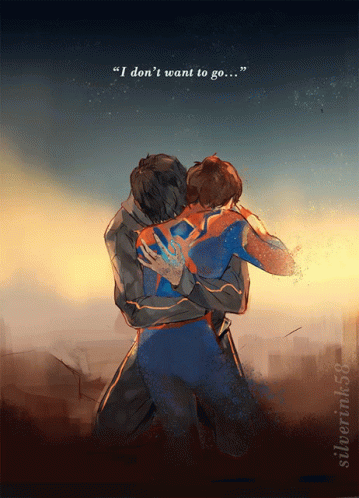How to Write A Truly Tragic Death Scene
By Allison Grace
“Noooo!” The hero runs across the battlefield to his fallen mentor. Falling to his knees beside the body, he begs his mentor to stay.
The mentor weakly opens his eyes for the last time and gasps, “You are the Chosen One. Fulfill your destiny.” Then he dies.
Cue the tragic soundtrack with haunting vocals.
If we’re honest, we’ve all written scenes like that.
We’re just trying to make the death feel real. But in the process, our readers wind up rolling their eyes instead of sobbing.
Frankly, our character’s death turns into a writing tragedy. We fall into melodrama and clichés.
But there is hope.
There is a way to avoid cheesy death scenes. Let’s take a look!
Spoiler Warning: Before you read on, know there are some pretty major spoilers ahead. I’ll be talking about Star Wars: A New Hope and Revenge of the Sith; Avengers: Infinity War and Endgame; Spider-Man: Homecoming; Captain America: Civil War; and The Fellowship of the Ring. You have been warned.
Foreshadow
In general, your characters shouldn’t die out of the blue. Yes, you may want to shock your reader but when they look back, they should realize his fate was inescapable.
For example, before watching Endgame, I knew Tony Stark was going to die (I’m still not over it). But Marvel did an excellent job of foreshadowing it.
Just think of all the other times he almost died saving the world. It only made sense that at some point he’d fall in the line of duty.
Excuse the poor wording, but his death was inevitable.
Gif credit: Tenor
Your reader doesn’t want their favorite character to die randomly. They want to look back at the events preceding his death and see your hidden hints.
Some good examples of foreshadowing are:
- Tony’s death was specifically foreshadowed when Captain America said Iron Man would never be the one to make the sacrifice play in the first Avengers movie.
- Spider-Man: Homecoming foreshadows Peter’s death when Tony says that if the kid dies, it would be on Tony’s conscience.
- Anakin Skywalker becoming Darth Vader was foreshadowed over numerous events in the prequels and the Clone Wars TV series. Most notably was when he slaughtered the entire Sand People village.
Give It a Point
Characters dying for no reason is really irritating. In real life, death is devastating (but we as Christians have hope after death!). It should be the same in your fictional world.
Their death should do something. It should move the plot along. Instigate a change in the main character. Force the other characters to come to grips with their own mortality.
And your point should not simply be to make the reader sob their eyes out. That’s not nice, okay?
At first glance, Peter Parker’s death in Infinity War seems to fit the category of “hehe, let’s watch the fans wail” but it has a deeper purpose than that. Once you watch Endgame, you see that Peter’s death is what drives Tony Stark to solve time travel and reverse the Snap. Without his death, Tony wouldn’t have been motivated to help the Avengers.
Gif credit: Tenor
(Whoever made this, it’s amazing.)
So yes, make your readers cry, but give their tears a purpose.
Avoid Gushy Emotions
Our first instinct when writing the aftermath of a death scene is to go on and on for pages about the characters’ grief. But this actually isn’t the best way to handle tragedy in writing.
My college creative writing textbook quotes Anton Chekhov: “When you describe the miserable and unfortunate, and want to make the reader to feel pity, try to be somewhat colder--that seems to give a kind of background to another’s grief, against which it stands out more clearly. Whereas in your story the characters cry and you sigh. Yes, be more cold.”
The author of the textbook, Heather Sellers, explains, “‘Going cold’ means that the more intense the emotion is [that your characters are feeling], the less intense the writing should be.”
Oftentimes, your character won’t have time to focus on the tragedy.
Think of when Gandalf died fighting the Balrog. The Fellowship didn’t stop and cry for ages. They had to keep moving.
Or when Luke Skywalker watched Vader slay his mentor. He had to finish rescuing the princess.
So don’t slow the action for pages wallowing in sorrow. Doing so brings the pacing to a screeching halt.
As you do so, remember your characters should feel something. If they are too cold, it will be just as unrealistic and frustrating as pages of sobbing.
And sometimes, the best reactions to a death scene are not the emotions but the way in which the surviving characters change because of it. Like after the Snap in Infinity War. All the Avengers handle their grief in a different way--Tony focuses on his family, Thor starts drinking, Steve counsels others, Nat keeps trying to protect the world, and Clint...well, he goes a bit crazy.
Actions speak louder than words and emotions. Any character can cry but only those truly affected will change.
Don’t Focus on the Death
Rather than writing pages of melancholy description, try focusing on one small element that stands in stark contrast to the death.
K.M. Weiland has a good video where she explains this concept:
Snag a tiny detail and use it as a magnifying glass for the whole scene. Instead of describing the smoking ruins, focus on the American flag still flying. Instead of dwelling on the blood-soaked battleground, note the picture of a soldier’s family lying in the mud.
These are the details I will remember when I close your book.
They reframe the sorrow of the scene and make us see it in a different light. By showing your reader an innocent detail, such as the butterfly Weiland mentions, it makes everything else stand out.
Avoid Cringy Dialogue
One of the ways we make our death scenes really annoying is by drawing out the character’s last words. They usually say something along the lines of “I love you,” “I’m sorry,” “Go on without me,” etc.
But what if their last words aren’t sappy? What if they don’t get a chance to say anything at all?
When Gandalf falls into the pit, he yells, “Fly you fools!” It’s definitely not what one would expect from a dying character. But it has become iconic.
Gif Credi: Giphy
Or what about when Tony Stark dies? Surely as he’s sitting there surrounded by his friends and family, he could say something. Yet he doesn’t. And it makes the scene all that more tragic. (Here’s an article explaining why he’s silent.)
Remember, a character’s last words are important. Most of the time, the character knows they are about to die and choses their words carefully. Whether you give them an opportunity to say them or not is up to you.
It Doesn’t Have to be a Physical Death
This last point might seem a bit off-topic, but I assure you, it’s not.
When we think about a death scene, we think of someone (probably the mentor) getting stabbed and dying in the hero’s arms. Then the hero proceeds to mourn and vows to take vengeance.
But what if you tried a different kind of death scene? What about the death of a dream, a relationship, or a treasure?
Everyone has experienced this kind of death. Everyone has a hope that got crushed, a dream that vanished into darkness, or a friendship that crumbled.
Sometimes, this type of “death scene” hurts more than if someone physically dies.
Remember the fight between Anakin Skywalker and Obi-Wan Kenobi at the end of Revenge of the Sith? Neither character physically dies. But it still hurts.
Or take the battle between Iron Man and Captain America in Captain America: Civil War. In this scene, there is no death. But you can see the characters’ friendship crumbling with each blow.
So before deciding your best bet is to kill a character, consider if turning them against the hero might improve the story.
As you prepare to write the death of a beloved character remember these few tips:
- Make the character’s death inevitable by skillfully utilizing foreshadowing.
- Don’t let them die in vain. Their sacrifice should drive the hero onward.
- Go cold. Don’t wallow in the grief.
- Focus on an unusual detail that stands out against the tragedy.
- Know when to use last words and when to remain silent.
- Sometimes the death of a dream or relationship hurts way more than physical loss.
- Bring lots of tissues.
Here are some more resources on writing death scenes:
Top 5 Myths to Avoid When Writing Grief
6 Tips for Writing Grief Realistically
3 Reasons You Should Kill A Main Character
Allison Grace
Allison Grace used to hate writing.
Now she can’t imagine a world without telling stories.
She has written several short stories and completed a novel. Her favorite themes to write about (fiction and nonfiction) are identity, faith, and redemption. She also has a whole stash of unfinished fan fiction no one is allowed to read.
Besides writing, Allison loves to crochet stuffed animals and dolls to give to charities. She is a shameless Star Wars and Marvel nerd and can carry on an entire conversation solely in movie quotes.
She blogs at allisongracewrites.com






Ooh! This was such a good article! I love all the points you made. Particularly about giving the readers tears a purpose XD.
Also, that Tony and Peter GIF? I agree. Amazing.
Thank you so much, Sandrina!
Ikr? I just stared at it for a while when I found it.
YES. Thank you for writing this. I have a death scene in my first book (yes, I’m that merciless) and so this will help me a LOT. Thank you so much!!
I do have one question though… would it interrupt the flow of the story to have one character in deep grief? In my story, two of the MCs are twin sisters, but one dies in an avalanche. Would it be okay, I guess, to have the other one sort of go into a depression without her? (And then learn to get over it, of course.)
Good question, Grace!
The short answer is yes. That would be a realistic reaction in real life.
What I’m advising you avoid is the ten-page description of the character alone in their bedroom, looking at a picture of their friend, and reminiscing on days gone by. That’s what really slows the story down, not the character grieving.
So in my example of Gandalf’s death, the Fellowship didn’t have time to stop and grieve. But it clearly affected them and shook them up. If Tolkien had made them all stop and reminisce for chapters on how kind Gandalf was and how he always had the best fireworks, the adventure would be put on hold.
Or when Peter died in Infinity War, it clearly was devastating to Tony. But the story doesn’t slow down. It keeps going. Instead of watching Tony grieve, we see how his grief affects his relationships, his goals, his personality, and his team.
So I’d say, in your story, that your character definitely could fall into depression. But I wouldn’t write about her in a room alone. I’d stick her at the dinner table, no matter how much she doesn’t want to be there, and show her grief through her interactions with the rest of her family. Does she believe they don’t care about what happened and they are just glossing it over? Then show that through her actions. Don’t just have her think it, have her demonstrate it.
Does that make any sense? I feel like that was long and rambly. XD
Ok, thank you so much! This was super helpful. Sometimes I feel like the action in my story is too fast XD Yes, that makes a lot of sense! Thank you!! 😀
You’re welcome!
This was fantastic! I’ll have to save this for when I go back over my WIP’s death scene–it needs the help! 😉
Thank you for reading, Gracie!
This is awesome! I love this! I will totally use this information!
Thank you, Scoutillus!
Nice! I have a few death scenes in my stories. Usually there, a character’s “last words” are not their last dying breaths; rather, a character who dies in the story is usually dead by the time the others get to him, so whatever I want him to say before his excision from the story is what he said before he fought the enemy, or leaped into the explosion/burning building or ship or whatever/vicious battle. I used this in one of my fan-fictions. Also, I agree with you on that GIF, and on the “Fly, you fools!” quote. I really liked the LOTR movies!
That’s a good idea for last words!
I first remember doing it in my most recent Warriors fanfic, “The Fire Prophecy,” when the warrior cat Kalevpelt (if you’ve read the warriors books you’ll know why his name is so weird) explains to his fellow warrior Quorraheart how he truly feels about her, since he senses he’s about to die.
Also, any advice on when a character dies of old age? Because I have a character which I had to let die of natural causes, because I realized he couldn’t live forever. (This guy was one of my favorites back when he was young, so it’s not like I don’t like him or anything.)
Hmm. I haven’t had any of my characters die of old age, and actually haven’t seen that very many other places. Apparently, writers prefer dramatic deaths instead. XD
If he knows he’s going to die, he’d probably get his affairs in order (sort out his money, be sure his will is correct, etc.) and say goodbye to his family. If he’s sick, he might not be able to do those things. So maybe have his family visit him in the hospital or wherever he is. I kinda feel like your character would die in his sleep. (I realize if your character is a cat, these might not apply. XD)
Does that help?
He did die in his sleep. But yes, I think that would be a good idea–saying goodbye to his remaining family.
Also, I saw your bio, and…..You and I have so much in common! I am a definite Marvel and Star Wars freak, too. And I have a zillion fanfics. Which is your favorite? What is it about?
*high fives*
My favorite is the ones I’m working on right now, a novel-length fanfic about Tony Stark overcoming his greatest fears.
Awesome. My favorite fanfic….Well, I can’t decide. I had a Avengers/Star Wars/How to Train your Dragon one once, where Tony Stark rode a Night Fury from the Star Wars planet Lothal….. I’m currently working on a Tron Legacy fanfic, and multiple warrior cats ones.
Tony Stark, Night Furies, and Lothal. That sounds awesome! (I love SW Rebels. =D)
Yay! Someone else who’s a Rebels/How to Train Your Dragon freak. Maybe someday I’ll show you “Dragon Riders, Assemble!” (That’s what it was called. Each Avenger had a dragon……)
This is an extremely helpful article! I filled at least three pages full of note-taking while reading this and it made me re-think the death of one of my characters. Perhaps making him turn against the MC would be more effective than having him die.
Question: or would it be terribly cliche to have the character turn against the MC, later help her, then die? I am just wondering before I begin setting the idea in stone:)
Also, the character in question happens to be a very close friend (almost kindred spirit to the MC). That doesn’t make things much easier on me, so I was just wondering what advice you might have.
I’m glad it was helpful!
Sorry it took so long to reply!
I don’t think that is cliche. As long as they really, truly turn against the MC and aren’t doing a double-agent kind of thing. *glances at her own characters who like to do that*
The closer the characters are, the worse the betrayal is. And I think if your MC knows her friend really well, she will know that it’s not fake.
So my best advice is to commit to the betrayal and if the friend winds up helping the MC again, that it’s not “just like old times.” The MC will have trouble trusting them and might even balk at their help.
Is that helpful? I feel like that was rambly. XD
@allisongrace
Oh, my goodness! That is super extraordinarily helpful!! That wasn’t rambly at all and it really helps clear up a lot about the characters:) Thank you so so much! 😀 Your response literally helped me make another breakthrough in my WIP:)
That and my MC already has an extremely hard time trusting people. And carrying out the betrayal instead of making them a double-agent *also coughs guiltily* I think it would be much more effective for the story.
Thank you so much for all these awesome tips! 😀
Hi, Abigail!!! 🙂 My advice might not be very good, but I like the idea of your character turning against your MC, then helping your MC before dying. That’s just my opinion. Do what works best for your story. I wish you the best of luck as you plan it out!!!!!! 🙂
Hi Kathrine! 🙂 Thank you so much, I appreciate it (I’ll need all the luck I can get XD ) Seriously though, thank you! 😀
This a great article! Whenever I want to write a tragedy I always have the character in question promise to do something else with someone else before hand (usually going to see the ocean or something) before I write the scene.
That’s one I think you might want to be a bit careful with. My family has watched a lot of old (like, pre-1970) war movies, and it’s gotten so we know that if someone is going to die, he is probably going to have a scene talking about his life/dreams/future, unlike every other guy in the story. It starts seeming pretty cliche-ish. BUT…it IS a reasonable way to foreshadow.
Thank you!
Ooo, that is tragic. I had my MC promise something to his wife. He thought he was going to die, but she did instead. *cries*
“His death was inevitable.”
Really? REALLY?
too soon, girl. too soon. 😉
I’m sorry. I couldn’t resist. XD
*goes to cry in the corner*
Girl, why are you so good?? 😄 Thanks so much for writing this, definitely will use it in the future…
Aww, thank you so much! <3
This post was incredible!!!!!!! Thank you so much!!!!!! A couple of weeks ago I wrote my first death scene. Reading this post really gave me some great ideas on how to make my MC react to the death of another character.
OOOOH, such good advice!! I really needed this, as I tend to write way too many death scenes :))
I loved this so much!!! This brought out several thing’s I’d never thought about before, so THANK YOU!!!!
I think Tony actually says “Pep” really, really quietly but other than that…augh yes. You could even say it was foreshadowed as early as the first Iron Man movie, but I don’t know how – maybe after the battle with Obadiah when the arc reactor is flickering?
Anyway…in my in-progress Civil War series, I plan on one of the main characters losing one of his older brothers at the Battle of Fredericksburg. The Northern Lights made an appearance on the night of the 14th, and after finding his brother dead, the MC sees the Lights and it causes him to remember a childhood memory of his brother.
Also, his brother’s last words to him are sometime before they get separated during the battle and it happens to be something he always told the MC growing up, so 😭.
Hi! I am writing a book with one of my friends. We are trying to be the youngest authors to write chapter books! I don’t really know how to put in a death scene of one of the main characters so this was extremely helpful.
Quick question, if I kill off the third main character, and they come back to life, would it be weird?
In case this gets published, please look for the book: Finding Panacea! It is going to be a series!
Thank you so much for this article! Trying to make stories heartfelt but it’s kinda hard to get it just right.